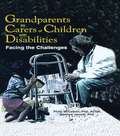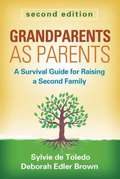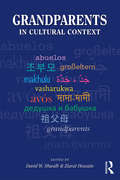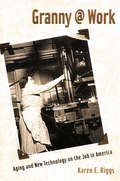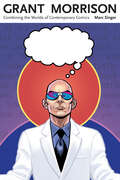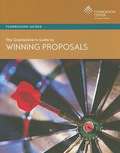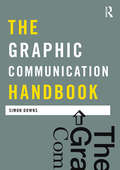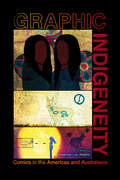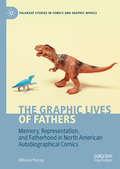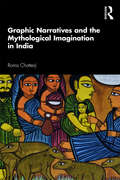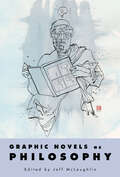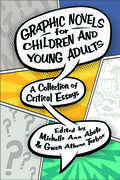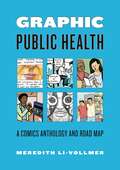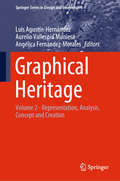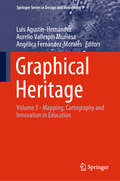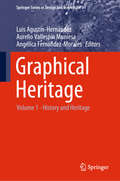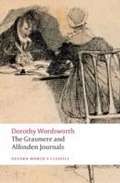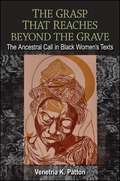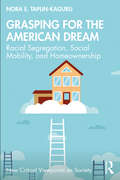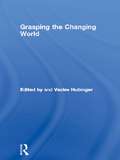- Table View
- List View
Grandparents as Carers of Children with Disabilities: Facing the Challenges
by Matthew Janicki Phillip MccallionOlder adults caring for developmentally disabled children have special needs. Are you and your agency doing all you can to help?Grandparents as Carers of Children with Disabilities: Facing the Challenges provides the first comprehensive picture of grandparents caring for children with developmental disabilities and their related requirements. Here you'll find information on the mental and physical health of these caregivers, highlighting their unique needs and the roles that agencies and advocates need to play in order to meet them. This unique volume will assist practitioners, administrators, and policymakers in including the needs of this group into planning and service delivery efforts.Grandparents as Carers of Children with Disabilities: Facing the Challenges takes an incisive look at: characteristics of these carers and the children they care for children in kinship care and their special needs the effect of kinship foster care on caregiving grandmothers the approach of Latino grandparents to bringing up children with special needs the service needs and provision issues of grandparent carers In this book, here is some of what you'll find: data from a school-based comprehensive multigenerational program in East Harlem, New York City, which explores environmental stressors associated with children coming into kinship care, discussing the impact on grandparent caregivers, with a focus on health status and access to care correlates of self-reported depressive symptoms among urban Latino grandparent caregivers a survey of grandparents (mostly African American, mostly female) caring for children with developmental disabilities in New York City that focuses on health status, emotional state, use of formal and informal services, and general life situation helpful charts and tables that put the facts at your fingertips a demonstration project that used an intervention model to determine how a three-pronged approach using outreach, support groups, and case management could be used to aid grandparents caring for children with developmental delay or disabilities ... and much more!As editors McCallion and Janicki point out, ”Primary childcare is rapidly becoming a normative experience of grandparenting. Grandparent primary care is found among all ethnic groups, and across all socioeconomic levels of society. Concern over preserving the family often causes grandparents to assume responsibility in spite of their limited financial means or own health conditions.” Grandparents as Carers of Children with Disabilities will enable you to provide these courageous, loving people with the help they need to do this extraordinarily difficult and often thankless job.
Grandparents as Parents, Second Edition
by Sylvie De Toledo Deborah Edler BrownIf you're among the millions of grandparents raising grandchildren today, you need information, support, and practical guidance you can count on to keep your family strong. This is the book for you. Learn effective strategies to help you cope with the stresses of parenting the second time around, care for vulnerable grandkids and set boundaries with their often-troubled parents, and navigate the maze of government aid, court proceedings, and special education. Wise, honest, moving stories show how numerous other grandparents are surviving and thriving in their new roles. Updated throughout, and reflecting current laws and policies affecting families, the second edition features new discussions of kids' technology use and other timely issues.
Grandparents in Cultural Context
by David W. Shwalb Ziarat HossainGrandparents in Cultural Context gives a long overdue global view of the changing roles of grandparents. The eleven main chapters are by experts in the Americas, Europe and Russia, Asia, and Africa and the Middle East, and the editors integrate their chapters with previous writings on grandparenthood. Rather than technical or statistical research reports, each chapter provides a thought-provoking and comprehensive review of research, real-life case stories, cultural influences, and applied implications for grandparenthood across and within societies. Calling special attention to the roles of grandfathers and grandparenthood in societies previously un-represented in the literature, it provides several hundred new citations of work previously unavailable in English-language publications. Accessible to both scholars and students, it has several pedagogical features (e.g. web links, discussion questions) that make it useful as a text for upper-division undergraduate or graduate level classes in behavioral, social, and family sciences. It is relevant to psychology, gerontology, family studies, anthropology, family/comparative sociology, education, social work, gender studies, ethnic studies, psychiatry, and diversity and international studies programs. Practitioners, service providers, policymakers, and internationally minded grandparents will also enjoy this book.
Granny D
by Doris Haddock Dennis BurkeIn February 2000, ninety-year-old Doris “Granny D” Haddock became a national heroine when she completed her 3,200-mile, fourteen-month walk from Los Angeles to Washington, D. C. , to bring attention to the issue of campaign finance reform. Granny Drecalls and celebrates an exuberant life of love, ac-tivism, and adventure—from one-woman feminist plays in the thirties, to stopping nuclear testing near an Eskimo fishing village in 1963, to her current crusade. Threaded throughout is the spirit of her beloved hometown in New Hampshire—Thornton Wilder’s inspiration for Grover’s Corners in Our Town—a quintessentially American center of New England pluck, Yankee ingenuity, and can-do attitude. Told in Doris’s vivid and unforgettable voice,Granny Dwill move and delight readers with its clarion message that one person can indeed make a difference.
Granny @ Work: Aging and New Technology on the Job in America
by Karen E. RiggsGranny @ Work is an impassioned comment on aging, work, and technology in American culture. As Riggs challenges popular assumptions with surprising research-for example, people over the age of 60 spend more time on the Internet than people of any other age group-and trenchant cultural critique, she forces us to confront the deeply entrenched ageism in today's technology-driven workplace.
Grant Morrison: Combining the Worlds of Contemporary Comics (Great Comics Artists Series)
by Marc SingerOne of the most eclectic and distinctive writers currently working in comics, Grant Morrison (b. 1960) brings the auteurist sensibility of alternative comics and graphic novels to the popular genres—superhero, science fiction, and fantasy—that dominate the American and British comics industries. Morrison's comics range from bestsellers featuring the most universally recognized superhero franchises (All-Star Superman, New X-Men, Batman) to more independent, creator-owned work (The Invisibles, The Filth, We3) that defies any generic classification. In Grant Morrison: Combining the Worlds of Contemporary Comics, author Marc Singer examines how Morrison uses this fusion of styles to intervene in the major political, aesthetic, and intellectual challenges of our time. Morrison's comics blur the boundaries between fantasy and realism, mixing autobiographical representation and cultural critique with heroic adventure. They offer self-reflexive appraisals of their own genres while they experiment with the formal elements of comics. Perhaps most ambitiously, they challenge contemporary theories of language and meaning, seeking to develop new modes of expression grounded in comics' capacity for visual narrative and the fantasy genres' ability to make figurative meanings literal.
Grants, Remittances, and the Equilibrium Real Exchange Rate in Sub-Saharan African Countries
by Joannes Mongardini Brett RaynerA report from the International Monetary Fund.
The Grantseeker's Guide to Winning Proposals
by Judith B. Margolin Elan K. DimaioPublished for development officers, nonprofit board members, fundraising consultants, and others in pursuit of grants from U.S. foundations, this guide provides real-world proposals that resulted in funding for a variety of needs, including general operating support, program development, staff salaries, and program evaluation. The featured proposals request anywhere from $5,000 to $500,000 in funding and were approved by international grantmakers such as the Charles Stewart Mott Foundation, large regional funders such as the Robert W. Woodruff Foundation, corporate donors such as the Mitsubishi Electric America Foundation, and local funders (including family foundations).
The Grapes of Math: How Life Reflects Numbers and Numbers Reflect Life
by Alex BellosFrom triangles, rotations and power laws, to cones, curves and the dreaded calculus, Alex takes you on a journey of mathematical discovery with his signature wit and limitless enthusiasm. He sifts through over 30,000 survey submissions to uncover the world's favourite number, and meets a mathematician who looks for universes in his garage. He attends the World Mathematical Congress in India, and visits the engineer who designed the first roller-coaster loop. Get hooked on math as Alex delves deep into humankind's turbulent relationship with numbers, and reveals how they have shaped the world we live in.
The Graphic Communication Handbook (Media Practice)
by Simon DownsThe Graphic Communication Handbook is a comprehensive and detailed introduction to the theories and practices of the graphics industry. It traces the history and development of graphic design, explores issues that affect the industry, examines its analysis through communications theory, explains how to do each section of the job, and advises on entry into the profession. The Graphic Communication Handbook covers all areas within the industry including pitching, understanding the client, researching a job, thumbnail drawings, developing concepts, presenting to clients, working in 2D, 3D, motion graphics and interaction graphics, situating and testing the job, getting paid, and getting the next job. The industry background, relevant theory and the law related to graphic communications are situated alongside the teaching of the practical elements. Features include: introductions that frame relevant debates case studies, examples and illustrations from a range of campaigns philosophical and technical explanations of topics and their importance.
Graphic Indigeneity: Comics in the Americas and Australasia
by Frederick Luis AldamaHonorable Mention Recipient for the Comics Studies Society Prize for Edited Book CollectionContributions by Joshua T. Anderson, Chad A. Barbour, Susan Bernardin, Mike Borkent, Jeremy M. Carnes, Philip Cass, Jordan Clapper, James J. Donahue, Dennin Ellis, Jessica Fontaine, Jonathan Ford, Lee Francis IV, Enrique García, Javier García Liendo, Brenna Clarke Gray, Brian Montes, Arij Ouweneel, Kevin Patrick, Candida Rifkind, Jessica Rutherford, and Jorge Santos Cultural works by and about Indigenous identities, histories, and experiences circulate far and wide. However, not all films, animation, television shows, and comic books lead to a nuanced understanding of Indigenous realities. Acclaimed comics scholar Frederick Luis Aldama shines light on how mainstream comics have clumsily distilled and reconstructed Indigenous identities and experiences. He and contributors emphasize how Indigenous comic artists are themselves clearing new visual-verbal narrative spaces for articulating more complex histories, cultures, experiences, and narratives of self. To that end, Aldama brings together scholarship that explores both the representation and misrepresentation of Indigenous subjects and experiences as well as research that analyzes and highlights the extraordinary work of Indigenous comic artists. Among others, the book examines Daniel Parada’s Zotz, Puerto Rican comics Turey el Taíno and La Borinqueña, and Moonshot: The Indigenous Comics Collection. This volume’s wide-armed embrace of comics by and about Indigenous peoples of the Americas and Australasia is a first step to understanding how the histories of colonial and imperial domination connect the violent wounds that still haunt across continents. Aldama and contributors resound this message: Indigeneity in comics is an important, powerful force within our visual-verbal narrative arts writ large.
The Graphic Lives of Fathers: Memory, Representation, and Fatherhood in North American Autobiographical Comics (Palgrave Studies in Comics and Graphic Novels)
by Mihaela PrecupThis book explores the representation of fatherhood in contemporary North American autobiographical comics that depict paternal conduct from the post-war period up to the present. It offers equal space to autobiographical comics penned by daughters who represent their fathers’ complicated and often disappointing behavior, and to works by male cartoonists who depict and usually celebrate their own experiences as fathers. This book asks questions about how the desire to forgive or be forgiven can compromise the authors’ ethics or dictate style, considers the ownership of life stories whose subjects cannot or do not agree to be represented, and investigates the pervasive and complicated effects of dominant masculinities. By close reading these cartoonists’ complex strategies of (self-)representation, this volume also places photography and archival work alongside the problematic legacy of self-deprecation carried on from underground comics, and shows how the vocabulary of graphic narration can work with other media and at the intersection of various genres and modes to produce a valuable scrutiny of contemporary norms of fatherhood.
Graphic Migrations: Precarity and Gender in India and the Diaspora (Asian American History & Cultu #222)
by Kavita DaiyaIn Graphic Migrations, Kavita Daiya provides a literary and cultural archive of refugee stories and experiences to respond to the question “What is created?” after decolonization and the 1947 Partition of India. She explores how stories of Partition migrations shape and influence the political and cultural imagination of secularism and contribute to gendered citizenship for South Asians in India and its diasporas. Daiya analyzes modern literature, Bollywood films, Margaret Bourke-White’s photography, advertising, and print culture to show how they memorialize or erase refugee experiences. She also uses oral testimonies of Partition refugees from Hong Kong, South Asia, and North America to draw out the tensions of the nation-state, ethnic discrimination, and religious difference. Employing both Critical Refugee Studies and Feminist Postcolonial Studies frameworks, Daiya traces the cultural, affective, and political legacies of Partition migrations. The precarity generated by modern migration and expressed through public culture prompts a rethinking of how dominant media represents gendered migrants and refugees. Graphic Migrations demands that we redraw the boundaries of how we tell the story of modern world history and the intricately interwoven, intimate production of statelessness and citizenship across the world’s communities.
Graphic Narratives and the Mythological Imagination in India
by Roma ChatterjiThis book explores graphic narratives and comics in India and demonstrates how these forms serve as sites on which myths are enacted and recast. It uses the case studies of a comics version of the Mahabharata War, a folk artist’s rendition of a comic book story, and a commercial project to re-imagine two of India’s most famous epics – the Ramayana and the Mahabharata – as science fiction and superhero tales. It discusses comic books and self-published graphic novels; bardic performance aided with painted scrolls and commercial superhero comics; myths, folklore, and science fiction; and different pictorial styles and genres of graphic narration and storytelling. It also examines the actual process of the creation of comics besides discussions with artists on the tools and location of the comics medium as well as the method and impact of translation and crossover genres in such narratives. With its clear, lucid style and rich illustrations, the book will be useful to scholars and researchers of sociology, anthropology, visual culture and media, and South Asian studies, as well as those working on art history, religion, popular culture, graphic novels, art and design, folk culture, literature, and performing arts.
Graphic Narratives of Organised Crime, Gender and Power in Europe: Discarded Footnotes (Routledge Studies in Gender, Sexuality, and Comics)
by Felia Allum Anna MitchellThis book presents a unique series of graphic narratives which offer a new way to recount the lived experiences and life stories of women involved in transnational organised crime groups, from victims to perpetrators. Based on ethnographic interviews, and police files, academic Felia Allum and artist Anna Mitchell together seek to tell individual stories while also contributing to broader discourses about crime, power relations and victimhood. The four graphic stories cover cutting-edge issues in crime including County lines and British gangs, Nigerian syndicates, Italian Mafias, and Albanian drug gangs, and all stories effectively and forcefully depict the voices of those who are often voiceless and hidden in a more complex social and criminal phenomenon. This book is suitable for students and scholars in criminology, sociology, gender studies and comics studies, as well as for the general reader.
Graphic Novels as Philosophy
by Jeff McLaughlinContributions by Eric Bain-Selbo, Jeremy Barris, Maria Botero, Manuel “Mandel” Cabrera Jr., David J. Leichter, Ian MacRae, Jeff McLaughlin, Alfonso Muñoz-Corcuera, Corry Shores, and Jarkko TuusvuoriIn a follow-up to Comics as Philosophy, international contributors address two questions: Which philosophical insights, concepts, and tools can shed light on the graphic novel? And how can the graphic novel cast light on the concerns of philosophy? Each contributor ponders a well-known graphic novel to illuminate ways in which philosophy can untangle particular combinations of image and written word for deeper understanding.Jeff McLaughlin collects a range of essays to examine notable graphic novels within the framework posited by these two questions. One essay discusses how a philosopher discovered that the panels in Jeff Lemire’s Essex County do not just replicate a philosophical argument, but they actually give evidence to an argument that could not have existed otherwise. Another essay reveals how Chris Ware’s manipulation of the medium demonstrates an important sense of time and experience. Still another describes why Maus tends to be more profound than later works that address the Holocaust because of, not in spite of, the fact that the characters are cartoon animals rather than human.Other works contemplated include Will Eisner’s A Contract with God, Alan Moore and David Lloyd’s V for Vendetta, Alison Bechdel’s Fun Home, and Joe Sacco’s Footnotes in Gaza. Mainly, each essay, contributor, graphic novelist, and artist is doing the same thing: trying to tell us how the world is—at least from their point of view.
Graphic Novels for Children and Young Adults: A Collection of Critical Essays (Children's Literature Association Series)
by Michelle Ann Abate & Gwen Athene TarboxWith contributions by Eti Berland, Rebecca A. Brown, Christiane Buuck, Joanna C. Davis-McElligatt, Rachel Dean-Ruzicka, Karly Marie Grice, Mary Beth Hines, Krystal Howard, Aaron Kashtan, Michael L. Kersulov, Catherine Kyle, David E. Low, Anuja Madan, Meghann Meeusen, Rachel L. Rickard Rebellino, Rebecca Rupert, Cathy Ryan, Joe Sutliff Sanders, Joseph Michael Sommers, Marni Stanley, Gwen Athene Tarbox, Sarah Thaller, Annette Wannamaker, and Lance WeldyOne of the most significant transformations in literature for children and young adults during the last twenty years has been the resurgence of comics. Educators and librarians extol the benefits of comics reading, and increasingly, children's and YA comics and comics hybrids have won major prizes, including the Printz Award and the National Book Award. Despite the popularity and influence of children's and YA graphic novels, the genre has not received adequate scholarly attention.Graphic Novels for Children and Young Adults is the first book to offer a critical examination of children's and YA comics. The anthology is divided into five sections, structure and narration; transmedia; pedagogy; gender and sexuality; and identity, that reflect crucial issues and recurring topics in comics scholarship during the twenty-first century. The contributors are likewise drawn from a diverse array of disciplines--English, education, library science, and fine arts. Collectively, they analyze a variety of contemporary comics, including such highly popular series as Diary of a Wimpy Kid and Lumberjanes; Eisner award-winning graphic novels by Gene Luen Yang, Nate Powell, Mariko Tamaki, and Jillian Tamaki; as well as volumes frequently challenged for use in secondary classrooms, such as Raina Telgemeier's Drama and Sherman Alexie's The Absolutely True Diary of a Part-Time Indian.
Graphic Public Health: A Comics Anthology and Road Map (Graphic Medicine)
by Meredith Li-VollmerAs we confront the challenges of emerging diseases, environmental health threats, and gaps in health equity, medical professionals need versatile communication tools that help people make informed decisions and engage them in constructive conversations about the health of their communities. This book illuminates the power of comics to meet that need.Graphic Public Health demonstrates the range and potential of comics to address topics such as immunization promotion, outbreak prevention, gun violence, opioid addiction prevention, and climate change. It features the work of acclaimed cartoonists Ellen Forney, David Lasky, and Roberta Gregory, pieces by up-and-coming artists, and comics that Meredith Li-Vollmer produced as a communications specialist for Seattle’s public health department. More than a collection of cartoons, this book connects comics with fundamentals of health communication and discusses why the form can be uniquely effective for these purposes. Each chapter focuses on the use of graphic public health in the context of four specific goals: health literacy, risk communication, health promotion, and advocacy. Li-Vollmer also includes guidance for practitioners getting started in creating comics for any form of public information, and especially for public health.Practical and purposeful, Graphic Public Health is a clarion call for the current era and an invaluable resource for public health professionals and advocates, scholars of comics and graphic studies, and fans of the graphic medicine genre.
Graphical Heritage: Volume 2 - Representation, Analysis, Concept and Creation (Springer Series in Design and Innovation #6)
by Luis Agustín-Hernández Aurelio Vallespín Muniesa Angélica Fernández-MoralesThis book presents the proceedings of the 18th International Conference on Graphic Design in Architecture, EGA 2020, focusing on heritage – including architectural and graphic heritage as well as the graphics of heritage. Consisting of two parts: “Representation and Analysis” and “Concept and Creation”, this second volume gathers selected contributions on topics ranging from graphic representation to the graphic presentation of ideas, i.e. artistic creation, to bridge the gap between graphic heritage and the graphics of heritage. Given its scope, this volume will appeal to architectural and graphic designers, artists and engineers, providing them with extensive information on new methods and a source of inspiration for future research and interdisciplinary collaborations.
Graphical Heritage: Volume 3 - Mapping, Cartography and Innovation in Education (Springer Series in Design and Innovation #7)
by Luis Agustín-Hernández Aurelio Vallespín Muniesa Angélica Fernández-MoralesThis book presents the proceedings of the 18th International Conference on Graphic Design in Architecture, EGA 2020, focusing on heritage – including architectural and graphic heritage as well as the graphics of heritage. The third of three volumes, this book discusses topics related to mapping, cartography and landscape, as well as innovative education methods, particularly in the context of teaching architectural heritage. It covers historical cartography and new cartographies, as well as methods for representing the landscape, and reports on different learning methods and practices, including classroom methods but also those involving more active participation and multidisciplinary and collaborative production. Given its scope, this book will appeal cartographers, designers and teachers, providing them with extensive information on innovative methodologies and a source of inspiration for their future work.
Graphical Heritage: Volume 1 - History and Heritage (Springer Series in Design and Innovation #5)
by Luis Agustín-Hernández Aurelio Vallespín Muniesa Angélica Fernández-MoralesThis book presents the proceedings of the 18th International Conference on Graphic Design in Architecture, EGA 2020, focusing on heritage – including architectural and graphic heritage as well as the graphics of heritage. This first volume gathers selected contributions covering theories, and new technologies and findings to help shed light on current questions related to heritage. It features original documentation studies on historical archives, 3D and solid representation of architectural objects, as well as virtual graphic representation and applications of augmented reality, all documenting and/or reconstructing the present, past and future of architectural objects. As such, this book offers extensive and timely information to architectural and graphic designers, urban designers and engineers, and industrial designers and historians.
The Grasmere and Alfoxden Journals
by Dorothy Wordsworth Pamela WoofDorothy Wordsworth's journals are a unique record of her life with her brother William, at the time when he was at the height of his poetic powers. Invaluable for the insight they give into the daily life of the poet and his friendship with Coleridge, they are also remarkable for their spontaneity and immediacy, and for the vivid descriptions of people, places, and incidents that inspired some of Wordsworth's best-loved poems. The Grasmere Journal was begun at Dove Cottage in May 1800 and kept for three years. Dorothy notes the walks and the weather, the friends, country neighbors and beggars on the roads; she sets down accounts of the garden, of Wordsworth's marriage, their concern for Coleridge, the composition of poetry. The earlier Alfoxden Journal was written during 1797-8, when the Wordsworths lived near Coleridge in Somerset. Not intended for publication, but to "give Wm Pleasure by it," both journals have a quality recognized by Wordsworth when he wrote of Dorothy that "she gave me eyes, she gave me ears."
The Grasp That Reaches beyond the Grave: The Ancestral Call in Black Women's Texts
by Venetria K. PattonThe Grasp That Reaches beyond the Grave investigates the treatment of the ancestor figure in Toni Cade Bambara's The Salt Eaters, Paule Marshall's Praisesong for the Widow, Phyllis Alesia Perry's Stigmata and A Sunday in June, Toni Morrison's Beloved, Tananarive Due's The Between, and Julie Dash's film, Daughters of the Dust in order to understand how they draw on African cosmology and the interrelationship of ancestors, elders, and children to promote healing within the African American community. Venetria K. Patton suggests that the experience of slavery with its concomitant view of black women as "natally dead" has impacted African American women writers' emphasis on elders and ancestors as they seek means to counteract notions of black women as somehow disconnected from the progeny of their wombs. This misperception is in part addressed via a rich kinship system, which includes the living and the dead. Patton notes an uncanny connection between depictions of elder, ancestor, and child figures in these texts and Kongo cosmology. These references suggest that these works are examples of Africanisms or African retentions, which continue to impact African American culture.
Grasping for the American Dream: Racial Segregation, Social Mobility, and Homeownership
by Nora E. Taplin-KaguruAfrican American homebuyers continue to pay more for and get less from homeownership. This book explains the motivations for pursuing homeownership amongst working-class African Americans despite the structural conditions that make it less economically and socially rewarding for this group. Fervent adherence to the American Dream ideology amongst working-class African Americans makes them more vulnerable to exploitation in a structurally racist housing market. The book draws on qualitative interviews with sixty-eight African American aspiring homebuyers looking to buy a home in the Chicago metropolitan area to investigate the housing-search process and residential relocation decisions in the context of a racially segregated metropolitan region. Working-class African Americans remained committed to homeownership, in part because of the moral status attached to achieving this goal. For African American homebuyers, success at the American Dream of homeownership is directly related to the long-standing dream of equality. For the aspiring homebuyers in this study, delayed homeownership was a practical problem for the same reasons, but they also experienced this as a personal failing, due to the strong cultural expectation in the United States that homeownership is a milestone that middle-class adults must achieve. Furthermore, despite using perfectly reasonable housing search strategies to locate homes in stable or improving racially integrated neighborhoods, the structure of racial segregation limits their agency in housing choices. Ultimately, policy solutions will need to address structural racism broadly and be attuned to the needs of both homeowners and renters.
Grasping the Changing World (European Association of Social Anthropologists)
by Václav HubingerAs different societies merge into one global society and face the concomitant crisis of identity, of purpose and interest, social anthropology urgently needs to bring its methodology up to date: new methods are needed to analyse, compare and understand different cultures across space and time.Grasping the Changing World collects papers read at the second biannual EASA conference in Prague in 1992. The conference took place in an extraordinary 'postmodern' setting. With the fall of communist regimes in Central and Eastern Europe old certainties and time-honoured concepts had become obsolete; at the same time, anthropology too was in upheaval, and long-established patterns of thought seemed inadequate to grasp the rapidly changing realities. These doubts and tensions are reflected in this collection.The first half of Grasping the Changing World focuses on ways of conceptualising, modelling and perceiving the present, while the second half reassesses the theoretical strength or otherwise of social anthropology as a modern science. Combining methodological rigour and originality, this collection will make invaluable reading for all students of social anthropology, sociology and politics and its methodology as it is applied to the comparison and understanding of societies across space and time.
